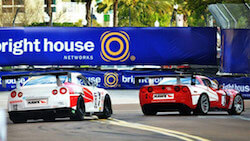Performance & Race Driving Tip
Speed Secret: Braking – where you start, the pressure you apply, how and where you release them – separates the consistent winners from the rest.
I don’t know of a driver today, from novice performance driver to elite-level pro racer, who didn’t at one point think that brakes were simply for slowing a car down.
 One thing that drivers learn over time (and the very best learn a lot about), is that brakes are used for much more than slowing the car down. Primarily, changing the balance of the car. Changing the direction of the car.
One thing that drivers learn over time (and the very best learn a lot about), is that brakes are used for much more than slowing the car down. Primarily, changing the balance of the car. Changing the direction of the car.
What? Not how late you can brake? Well, if you focus on the above, how late you begin braking will look after itself.
Where you begin braking is not as important as where you finish braking. Okay, you need to begin your braking somewhere near the point where you’ll need to brake near the limit. But you don’t need to brake at the very, very, very last second.
The best brakers I know do one thing in common: they focus their vision to what I call the End-of-Braking (E-o-B) point, rather than the Begin-of-Braking (B-o-B) point. (Yes, I’ve written about this in the past, but I’m repeating myself – in a different way – to make a point of how important this is) Again, they have a good idea where the B-o-B point is, but they really just see it with their peripheral vision. Their main focus is to that point where their foot finally releases the brakes and comes off the pedal.
And that’s my suggestion to you. The next time you hit the track, practice looking to the E-o-B point. It forces you to look further ahead, and it will help you brake better. And by better, I mean a smooth but hard initial application of the brakes, and then beginning to release the pressure as you get closer to the E-o-B point.
When you do this, you’ll likely brake close to the very last second, but you’ll release the pedal better, allowing you to enter the turns with slightly more speed (while still being able to begin accelerating as early, or earlier, than ever before).
Think of your brakes as a tool for setting your corner entry speed, and your car’s attitude when entering turns, rather than just a tool for slowing the car down.
As you progress and develop your driving skills, deliberately work on:
- The overall pressure you apply to the brake system – how quickly you ramp up to maximum pressure.
- When you begin to release brake pressure – how quickly, or the rate, that you release the pressure.
- Looking for the End-of-Braking point to establish where you begin, and how you end braking.
Check back here often for more tips and advice for performance drivers, race drivers, high performance driving instructors, and anyone else interested in learning to get around race tracks quickly.
Please do me favor and share this now with others who you think would either learn something from it, or enjoy it, by clicking on any of the links below. Thank you!

Great tip! Your terminology will help clarify. Looking at the next apex is not enough. This is a challenge to explain to drivers who conider themselves advanced. Much better to get the throttle-on-point right and sneak up on the EoB. My opinion is braking is the masterclass and one of the most difficult because, if done improperly, you can end up off the track or into a barrier. Best to pick corners with clear run-off for practice.
Great article
I do have a question per the clip below
why does the driver tap the brake before the full application?
is this to check brake pressure or this brush braking?
Thank you
https://youtu.be/qdWSyrqEnE4
It’s to make sure the brakes are firm when they get to the brake zone – to take the “pad knock back” out of the pedal. I answered this question in an Ask Ross piece here: https://speedsecrets.com/ask-ross/why-do-some-drivers-pump-tap-the-brakes-prior-to-a-corner/
Thanks for the question.